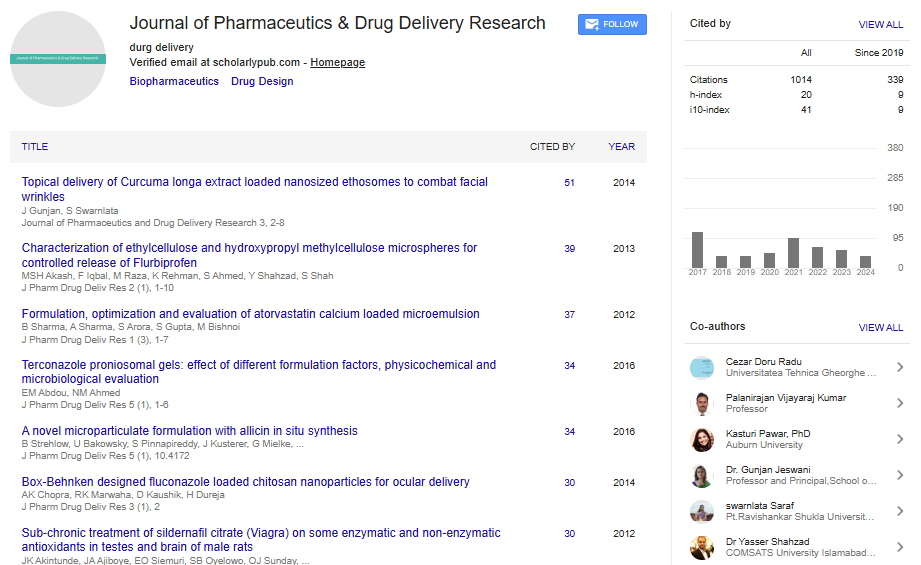Preparation of nano-EGCG loaded in situ gel for significantly enhancement of stability and long-term delivery
Shufang Nie
Nutrilite Health Institute, USA
: J Pharm Drug Deliv Res
Abstract
Purpose: To prepare a new EGCG delivery system by utilizing nano-EGCG loaded thermo-reversible in situ hydrogel to enhance EGCG stability and resident time in adipose tissue ablation. The present study may poetically provide a better way to achieve a maximum therapeutically benefit of nano-EGCG on abdominal obesity treatment. Methods: Nano-EGCG was prepared using a phase inversion-based process by encapsulating EGCG into chitosan coated nanostructured lipid carriers. Nano-EGCG was then dispersed into thermo-reversible Pluronic® F127-based hydrogel by cold method. The sol-gel transition temperatures were evaluated using inverted tube method. The stability of native EGCG, nano-EGCG solution, nan-EGCG loaded gel were investigated in 1×PBS (pH=7.4) at 37 °C for 15 days. In vitro EGCG release from nano-EGCG loaded in situ gel was detected by a membrane-less diffusion method. In vitro cytotoxicity and cellular triglyceride accumulation in 3T3-L1 adipocytes cells were determined by MTT and an enzymatic method, respectively. Results: The size of nano-EGCG obtained in this study was about 50 nm in diameter and PI values was relative low (<0.3) which indicates a high level of uniformity. Chitosan was used as a coating material to enhance the stability and bioactivity of nano-EGCG. The inverted tube method showed that 20% of F127 PBS (pH 7.4) solution with lipid nano-carrier amount equal to or lower than 6.25% exhibited reversal thermal gelation, transforming from liquid into a semisolid gel in 1-2 minutes at the characteristic sol-gel transition temperature 35.0 °C. When nano-EGCG was incorporated into an in situ thermo-reversible Pluronic® F127-based hydrogel, the stability of EGCG was dramatically improved which is in the order: Nano-EGCG loaded gel>nano-EGCG solution>native EGCG. The stability of EGCG can be further improved by addition of 0.05% EDTA-Na in the formula. The results showed that 80.3% of EGCG was still remained in nano-EGCG loaded gel while 20.0% and 0% of EGCG could be detected in nano-EGCG and native EGCG solution, respectively, after storing in neutral 1×PBS at 37 °C for up to 15 days. As compared to 20 uM of native EGCG, nano-EGCG with 0.05% EDTA-Na at the same concentration produced a lower triglyceride accumulation in mature 3T3-L1 adipose cells. In vitro release study showed that a steady sustained release of EGCG was realized by incorporating nano-EGCG into an in situ hydrogel, which produced a desired EGCG concentration range (10-30 uM) in the target tissue with the longer resident time (30 hours) for maintaining the continued anti-adipogenic effects. After treating mature 3T3-L1 adipose cells with 20 uM of native EGCG, nano-EGCG or nano-EGCG loaded hydrogel (20% F127) for 48 hours, cell viability was more than 85% among all treatments, which indicate they had a very low level of cellular toxicity. Conclusion: Experiments in vitro in the present study demonstrated that the combination of nano-EGCG with in situ gel can dramatically enhance the stability and produced a localized and sustained delivery of EGCG to adipose tissue ablation, which may potentially provide a better way to reduce abdominal fat through intra-peritoneal injection in abdominal obesity without inducing tissue toxicity.
 Spanish
Spanish  Chinese
Chinese  Russian
Russian  German
German  French
French  Japanese
Japanese  Portuguese
Portuguese  Hindi
Hindi 
